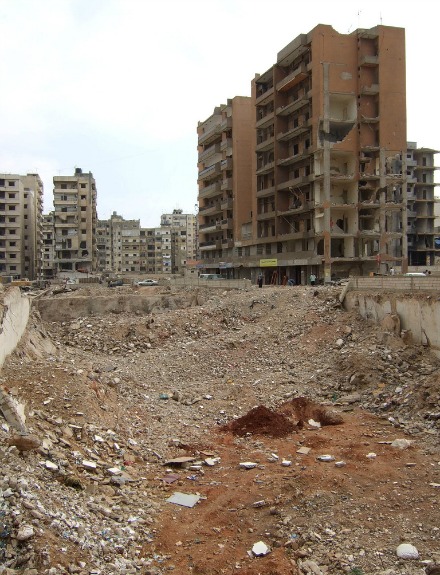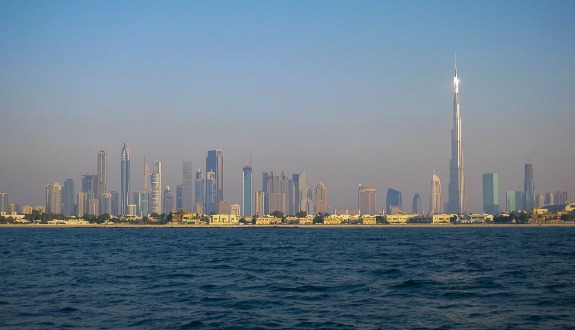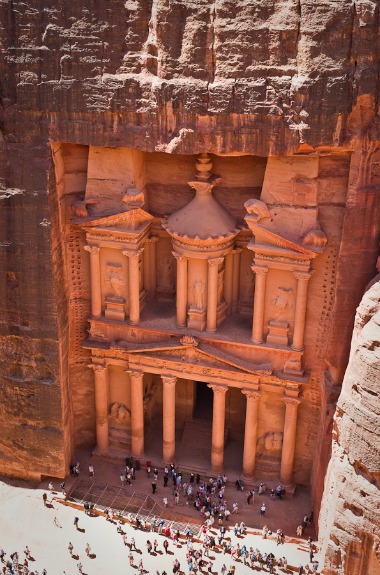Should Americans Travel to the Middle East?
Today the area is often perceived as a murky and dangerous blur on the map. But how unsafe, really, is this area for tourists?
Often the crux of conversation about nuclear threats and U.S. foreign policy, Iran has a lesser-known side of hospitality to travelers. Among its most popular tourist attractions is the ruined city of Persepolis. Photo courtesy of Flickr user Sebastia Giralt.
India and Turkey are currently two of the hottest tickets for traveling Americans—but the arid Muslim nations in between are not. Once an exotic region hospitable to travelers, the Middle East has changed—especially in recent tumultuous years, and today the area is often perceived as a murky and dangerous blur on the map, and many otherwise adventurous travelers have placed all nations from the Nile to the western Himalayas essentially off-limits. A popular assumption is that Americans are not wanted there—understandable considering the events surrounding 9/11, America’s invasion of Iraq, the war in Afghanistan, the imprisonment of three U.C. Berkeley graduates in 2009, the recent Islamic outrage over the YouTube video mocking the prophet Muhammad, and, most recently, the murder of four Americans in Libya, including Ambassador Chris Stevens. But rather than red-list every nation of this diverse and misunderstood corner of the planet, let us consider which remain hospitable to travelers—and also feature must-see-before-we-die sites.
Iran. Friendly, generous, inviting, gracious. Such is the general description bestowed by traveling Americans upon the Iranian citizens who have welcomed them. Though the Iranian government requires that American visitors arrange a group tour or travel with a private guide, tourists report having plenty of opportunities to visit sites unchaperoned and interact independently with locals. If you go, you may wish to see the ancient city of Persepolis and the Friday Mosque. The mountains near Iran’s northern borders are also gorgeous—and the wild abode of the Syrian brown bear—but keep in mind that this is where the three U.S. hikers seem to have been arrested in 2009. Also note that there is no U.S. Embassy or consulate in Iran, that your ATM and credit cards will probably not work, and that Iranians may be very fussy about what you wear in public. Moreover, the U.S. government issued a warning to traveling U.S. citizens on April 27, encouraging them “to carefully consider the risks of travel to Iran.” Hostile “elements” are a considerable concern, the warning states, and the American government’s ability to assist its citizens in times of trouble is “extremely limited.”
Saudi Arabia. Traveling is difficult in Saudi Arabia for Americans, if not dangerous. According to the travel warning issued by the U.S. government on May 18, “There is an ongoing security threat due to the continued presence of terrorist groups, some affiliated with al-Qa’ida, who may target Western interests…and facilities where Westerners congregate.” It makes visiting this land of crude oil and enthusiastic religion sound less than lovely. But if you insist on going, you’d better make it for business, as Saudi Arabia does not currently grant tourist visas. Instructions are available online for obtaining a work visa, a business visa or several other forms of entry permit. Travelers should note that their visit duration may be given in lunar, not Western, months—a detail that can fool visitors into overstaying by several days. This can mean a fine of almost $3,000 and incarceration. Also remember that during your business travels in Saudi Arabia, you may have to stop short at the gates of Mecca, inside of which non-Muslims are forbidden.
Israel. Make this the last country you visit on your Middle East tour, as port officials in Muslim nations may bar entry to anyone bearing evidence of having associated with Israel—like entry and exit stamps on your passport. A country of holy sites and biblical geography, high mountains, vineyards and beaches, it is also a land of sweltering political tensions. Ongoing hostilities with its neighbors make Israel an enemy to much of the Muslim world. (Even in Turkey, this animosity is thick—and I was almost arrested while cycling along the Black Sea in August 2010 when Turkish police mistook me for an Israeli. The encounter turned into handshakes, smiles and sightseeing suggestions when I produced my American passport.) USA Today Travel suggests staying out of crowds and abstaining from participation in political protests in Israel. Though a political friend of the United States, Israel can offer dangers to American tourists. The U.S. government advises staying “mindful of security factors” while planning a trip to Israel—and avoiding the Gaza Strip altogether.

Images like this one portray and reinforce a common perception of the Middle East as a land of ruined cities scarred by war and terrorism. This image shows the aftermath of a 2006 Israeli strike on Beirut, Lebanon. Photo by Flickr user delayed gratification.
Egypt. The land of the great pyramids, the sphinx and the desert shores of the Red Sea has been in the news lately through coverage of heated protests at the U.S. Embassy—but such unrest and anti-American sentiments may be entirely unrepresentative of Egyptian people’s general feelings toward Westerners. In fact, the American government has issued no formal warning against visiting Egypt, as it has with nearly every other Middle East country. According to this travel article in the Huffington Post, “Americans sailing down the Nile in Luxor at this very moment are having a great time. Those visiting Aswan report no incidents. And those vacationing in Alexandria are there, making new friends.” The same article points out that the rioters skirmishing with police amount to less than 300 dissidents. Yet tourism is down in Egypt, leaving some of the most famous sites of the ancient world to be enjoyed in the absence of the teeming masses of visitors that generally congregate before the pyramids and other such attractions. Consider going now, before the crowds surge back.
Dubai. Travel in the United Arab Emirates (UAE) is generally considered safe, and that has helped make Dubai, the UAE’s most famous city, one of the hottest tourist destinations in the Middle East. It is a center of skyscrapers, malls, resorts and glittering urban extravagance—most of it generated by the region’s oil reserves. The world’s tallest building stands in Dubai—more than half a mile in height—and the world’s most expensive cocktail was sold here for just shy of $8,000 (plus a buck, we may suppose, for the tip). If you were hoping to see austere holy sites and crumbling ruins, then Dubai is not for you.

Dubai is known as an island of calm and peace in a tumultuous area—-but its glittering facade of extravagant wealth and indulgent luxury will be a turnoff to some travelers. Photo courtesy of Flickr user Eugene Kaspersky.
Jordan. The problem with American perceptions of the Middle East is exactly that: They are perceptions of a large and unofficially demarcated area containing different cultures and a variety of landscapes and languages. All that millions of outsiders really know for sure about the area is that missiles seem to fly readily across international boundaries and turn outdoor markets and shopping centers into rubble. In Jordan, the recently foiled terrorist attack produced a scare, though authorities say the perpetrators were under watch every step of their way. In fact, Jordan has remained relatively peaceful through years of violence in its neighboring countries—yet the country may suffer from associations with violence, as Jordan shares borders with five nations, including Iraq, Syria, Israel and Saudi Arabia. But travelers who have gone there to see for themselves often return with glowing reports of Jordanians’ hospitality and genuine kindness. The nation is largely of red-hued desert and rough and rocky hills, and amid this landscape are such spectacular historical sites as Jerash, the Ajloun Castle and Petra, the ancient city included in Smithsonian Magazine‘s list of 28 places to see before you die.
Libya. Put your family vacation plans to Libya on hold for a while. Perhaps a few miles too far west to be categorized as a “Middle East” nation, Libya’s Muslim populace and hostility toward American earns this Saharan nation a place in this discussion. U.S. Ambassador Chris Stevens and three American colleagues were killed here during a siege of the U.S. consulate in Benghazi on September 11. (Note: Libyans were killed, too, as they tried to protect the Americans.) The next day the U.S. government issued a stern and formal warning against any travel at all in Libya. Take the advice–unless the rest of the world is really not enough.
For the following nations of the Middle East (or adjacent to it), the U.S. government has issued travel warnings this year: Iraq, Afghanistan, Syria, Lebanon, Pakistan, Somalia, Sudan, Yemen. Like so many nations, though, each of these likely has its highly publicized dark side, and its lesser-known archaeological attractions, hospitality and scenery.
What about Turkey? Escalating conflict between Syria and Turkey have raised concerns that travel in the latter will become unsafe. However, those who have recently been in Turkey deny that tensions or danger is increasing there. Rather, life has continued as usual, especially in the western realms of the nation. In related gossip, a number of nightmare scams reportedly pulled recently on women travelers in Istanbul may shock readers and open the eyes of travelers—but the stories, described here, probably illustrate nothing more hostile than snake-eyed thieves preying on unsuspecting outsiders.

Tourists in Jordan gather at Petra, an ancient city carved into the rock on the slope of Mount Hor. Photo courtesy of Flickr user sharnik.
Planning Your Next Trip?
Explore great travel deals
Smithsonian magazine participates in affiliate link advertising programs. If you purchase an item through these links, we receive a commission.
/https://tf-cmsv2-smithsonianmag-media.s3.amazonaws.com/accounts/headshot/Off-Road-alastair-bland-240.jpg)

/https://tf-cmsv2-smithsonianmag-media.s3.amazonaws.com/accounts/headshot/Off-Road-alastair-bland-240.jpg)